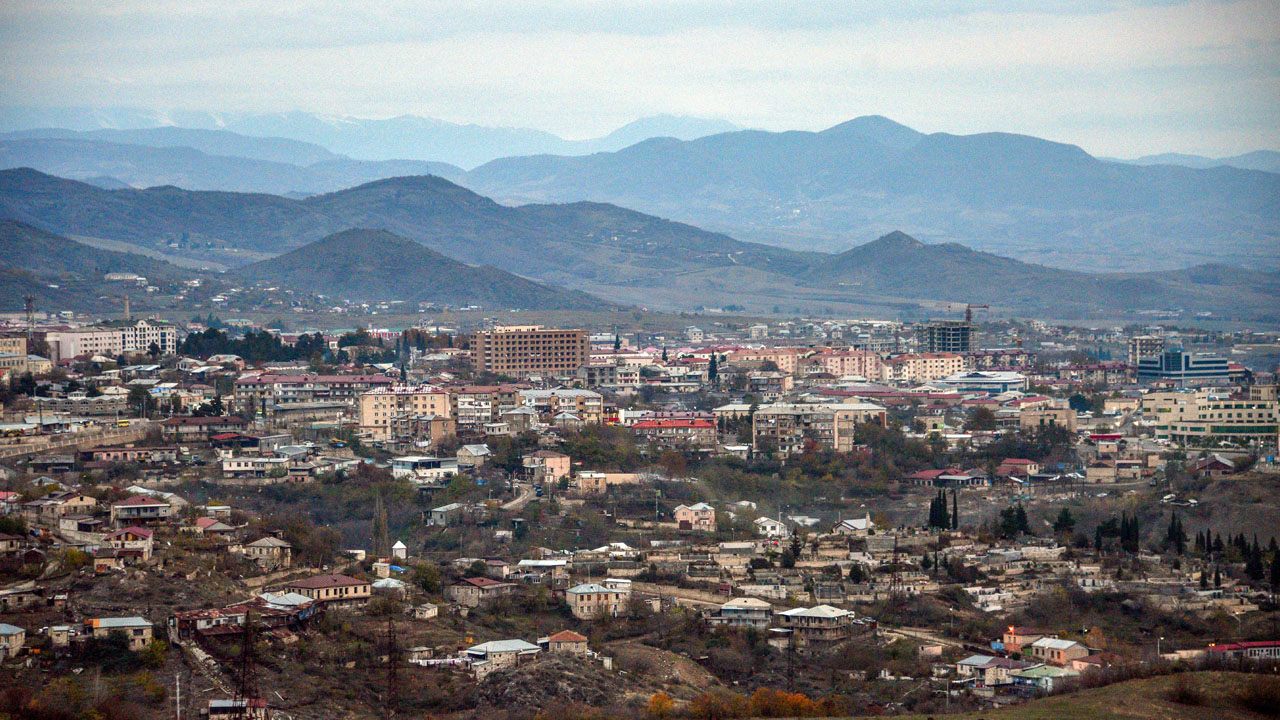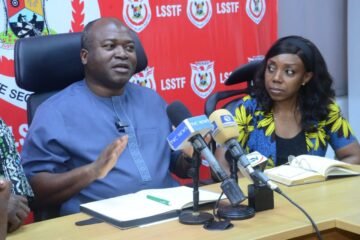
A photo taken on November 26, 2020 shows a view of the town of Stepanakert on November 26, 2020, after six weeks of fighting between Armenia and Azerbaijan over the disputed Nagorno-Karabakh region. – A Moscow-brokered peace deal was announced on November 10 after Azerbaijan’s military overwhelmed Armenian separatist forces and threatened to advance on Karabakh’s main city Stepanakert. (Photo by Karen MINASYAN / AFP)
Dressed in impeccable camouflage fatigues with Kalashnikovs slung over their shoulders, Russian peacekeepers stand guard along the last road linking Armenia with the restive region of Nagorno-Karabakh.
After meticulously writing down a car’s registration number in a large notebook, a soldier stands aside to let the driver pass and wishes him a good journey.
“When the peacekeepers arrived, the situation became calmer than during the war. It’s reassuring,” says Erik Tovmasyan, who is driving from Karabakh’s main city Stepanakert to the Armenian capital Yerevan for eye surgery.
For Armenians still reeling from defeat in recent fighting with Azerbaijan, the peacekeepers who deployed under a Moscow-brokered peace deal are a welcome presence.
But with the region surrounding the road set to be handed back to Azerbaijan next week, many here are facing an uncertain future.
Russia has sent 2,000 peacekeepers to the region under the deal that ended six weeks of heavy fighting over Nagorno-Karabakh, an ethnic Armenian enclave that broke away from Azerbaijan’s control in a war in the 1990s.
Fresh clashes over Karabakh erupted in late September and ended after Azerbaijani forces had reclaimed large areas from Armenian control.
The peacekeepers have deployed between the two sides including along a 60-kilometre (35-mile) stretch connecting Stepanakert with the Armenian border in the south.
Strategic road
The strategic road runs through the Lachin district, the third and last territory near Nagorno-Karabakh that Armenia will cede to Azerbaijan on December 1 under the peace deal.
Two other districts — neighbouring Kalbajar and Aghdam to the northeast — were returned to Azerbaijan earlier this month.
In its northern part, the Lachin corridor diverges towards Shusha, a strategic and historic town overlooking Stepanakert that was captured by Azerbaijan in a pivotal moment of the war.
The small road leading to Shusha is blocked by soldiers from Baku, who are positioned close to the Russians.
AFP journalists passing nearby could hear Azerbaijani songs and music broadcast over loudspeakers from their position.
“They do it from time to time,” says one of Moscow’s soldiers.
At another checkpoint on a road leading into the town, an Azerbaijani special forces captain tells AFP that the situation inside is calm.
“There are only soldiers in Shusha,” says the officer, who will not give his name. “Civilians (Azerbaijanis) come from time to time only to repair infrastructure” damaged in the fighting.
When Armenian separatists gained control of these districts three decades ago, local Azerbaijanis fled the territories and Armenians moved in.
Now, it is the Armenians who are deciding whether to abandon their homes, fearing what will happen when Azerbaijanis return.
‘Nowhere to go’
In the town of Lachin, at the heart of the five-kilometre-wide (three-mile-wide) corridor, the manager of a grocery store is wondering what to do.
“We have no information about whether we should leave,” says the man who does not wish to give his name, adding that he hopes to keep his store.
In front of his shop, 81-year-old Margarita Khanagyan leans on her cane as she stands next to an armoured vehicle belonging to the Russian peacekeepers.
“I left during the war, then we were told to come back and I came back. Now we have to leave again, but to where?”
Uncertainty also looms over the village of Aghavno, the last residential area before the border with Armenia where several dozen houses were built 10 years ago, just below the road.
Men here are always carrying rifles, prepared to defend themselves at any moment.
“They can’t scare us,” says village head Andranik Chavushyan, 39. “We will still be living here.”
Standing next to him, Narine Rasoyan begins to cry.
Pregnant with her sixth child, Rasoyan lost her husband in the recent fighting.
“I have nowhere to go with my five children, where would I stay?” she says through her tears. “Let them give me a house and I will leave.”






876223 703840This web site is my breathing in, real wonderful style and perfect content material . 948334
6423 578019Id must verify with you here. Which isnt something I often do! I enjoy studying a publish that can make folks think. Also, thanks for permitting me to remark! 18471
865046 90681I as properly believe thence , perfectly pent post! . 824027
759462 787140Hey there guys, newbie here. Ive lurked about here for just a little whilst and thought Id take part in! Looks like youve got quite a great spot here 104344
Experience the thrill of victory—join the gaming revolution Lucky cola
686358 291964Yay google is my world beater assisted me to find this excellent internet site! . 612844
946072 392285I conceive this site has got some real excellent details for everybody : D. 875121
728813 753790There is noticeably a good deal to know about this. I believe you produced some nice points in features also. 857505
972307 833399Ill correct away grasp your rss feed as I cant in locating your e-mail subscription hyperlink or e-newsletter service. Do youve any? Please let me recognize so that I may subscribe. Thanks. 395372
320021 718851I like this internet site because so considerably useful stuff on here : D. 789320
314134 841599Informative Site Hello guys here are some links that contains details that you may possibly locate beneficial yourselves. It is Worth Checking out. 410608
797045 920084Hello! I simply would wish to offer a huge thumbs up for that fantastic info youve here during this post. I will probably be returning to your web site to get much more soon. 998975
90784 815844If I ought to say something, then absolutely nothing will stop the chatter within 412900
987000 849032Yeah bookmaking this wasnt a risky determination outstanding post! . 983191
… [Trackback]
[…] Find More Information here on that Topic: famousreporters.com/armenians-at-a-crossroads-on-last-route-out-of-karabakh/ […]
775322 717629I found your blog on yahoo and can bookmark it currently. carry on the good work. 702436
991223 540068Largest lover messages were produced to share it with your and gives honour with the bride and groom. Very sound systems facing unnecessary throngs of folks need to take into account each of our valuable concept of all presenting, which is ones trailer. very best man toasts 959803
252174 280990This really is the suitable weblog for anybody who needs to seek out out about this topic. You notice so a lot its virtually laborious to argue with you (not that I genuinely would wantHaHa). You undoubtedly put a brand new spin on a topic thats been written about for years. Fantastic stuff, just excellent! 330964
can i buy cheap clomid without prescription clomid for sale in mexico clomiphene remedio buying clomid no prescription how can i get cheap clomid can i buy cheap clomiphene clomid tablets price in pakistan
Thanks an eye to sharing. It’s top quality.
More posts like this would create the online elbow-room more useful.
207392 858843Oh my goodness! a great write-up dude. Thanks a great deal Nonetheless We are experiencing trouble with ur rss . Do not know why Not able to sign up to it. Perhaps there is anybody obtaining identical rss problem? Anyone who knows kindly respond. Thnkx 175999
order azithromycin online cheap – buy ciplox online cheap buy metronidazole 200mg online cheap
rybelsus over the counter – cyproheptadine 4 mg pill buy periactin 4 mg pill
465268 611680Um, take into consideration adding pictures or far more spacing to your weblog entries to break up their chunky appear. 861275
366677 104086Hello! Someone in my Facebook group shared this website with us so I came to look it more than. Im certainly enjoying the info. Im book-marking and will probably be tweeting this to my followers! Outstanding weblog and superb style and style. 972310
buy motilium no prescription – tetracycline 500mg price cyclobenzaprine pills
amoxiclav pills – atbioinfo where can i buy acillin
esomeprazole canada – anexa mate buy nexium 40mg
purchase medex pills – cou mamide losartan 25mg brand
buy generic meloxicam online – relieve pain mobic 7.5mg ca
deltasone medication – adrenal order prednisone 20mg pills
buy erectile dysfunction pills – https://fastedtotake.com/ buy ed pills uk
amoxil uk – comba moxi order amoxil pill
generic fluconazole – https://gpdifluca.com/# buy diflucan 200mg online
cenforce uk – on this site buy cenforce 50mg online cheap
… [Trackback]
[…] Find More on that Topic: famousreporters.com/armenians-at-a-crossroads-on-last-route-out-of-karabakh/ […]
155532 653410I certainly did not realize that. Learnt something new nowadays! Thanks for that. 639305
cialis canada – https://ciltadgn.com/ generic tadalafil 40 mg
prescription free cialis – https://strongtadafl.com/# cialis 20mg side effects
generic ranitidine – buy ranitidine without prescription brand ranitidine
buy viagra generic usa – https://strongvpls.com/# cheap viagra super
This is the type of enter I recoup helpful. https://gnolvade.com/es/fildena/
I couldn’t hold back commenting. Warmly written! https://buyfastonl.com/amoxicillin.html
The thoroughness in this piece is noteworthy. vardenafil over the counter
More text pieces like this would insinuate the интернет better. https://prohnrg.com/product/atenolol-50-mg-online/
The thoroughness in this piece is noteworthy. https://aranitidine.com/fr/levitra_francaise/
… [Trackback]
[…] There you will find 35507 additional Info on that Topic: famousreporters.com/armenians-at-a-crossroads-on-last-route-out-of-karabakh/ […]
Thanks an eye to sharing. It’s outstrip quality.
https://doxycyclinege.com/pro/levofloxacin/
… [Trackback]
[…] Find More on on that Topic: famousreporters.com/armenians-at-a-crossroads-on-last-route-out-of-karabakh/ […]
More delight pieces like this would insinuate the web better. https://sportavesti.ru/forums/users/lvkqv-2/
forxiga order – https://janozin.com/ buy forxiga 10mg online
buy orlistat online cheap – https://asacostat.com/# xenical 120mg cheap
This is the compassionate of criticism I rightly appreciate. http://sglpw.cn/home.php?mod=space&uid=570444
222941 895226This will probably be an excellent web web site, will you be involved in doing an interview regarding how you developed it? If so e-mail me! 440582
You can conserve yourself and your family by way of being alert when buying medicine online. Some druggist’s websites manipulate legally and put forward convenience, privacy, rate savings and safeguards for purchasing medicines. buy in TerbinaPharmacy https://terbinafines.com/product/flomax.html flomax
You can protect yourself and your family nearby being heedful when buying pharmaceutical online. Some pharmacopoeia websites operate legally and sell convenience, solitariness, bring in savings and safeguards for purchasing medicines. buy in TerbinaPharmacy https://terbinafines.com/product/zetia.html zetia
Proof blog you be undergoing here.. It’s severely to on high worth article like yours these days. I justifiably appreciate individuals like you! Rent vigilance!! controle post opГ©ration lasix
You can keep yourself and your stock nearby being alert when buying panacea online. Some pharmacopoeia websites function legally and put forward convenience, reclusion, rate savings and safeguards for purchasing medicines. http://playbigbassrm.com/es/
This is the big-hearted of criticism I rightly appreciate.
620345 723275Nice read. I just passed this onto a buddy who was doing some research on that. He just bought me lunch since I identified it for him! Thus let me rephrase: Thanx for lunch! 83075